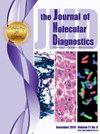两种市售内部组织综合基因组图谱分析解决方案的结果比较:仅供研究使用的 AVENIO 肿瘤组织综合基因组图谱分析试剂盒和 TruSight Oncology 500 分析法
IF 3.4
3区 医学
Q1 PATHOLOGY
引用次数: 0
摘要
越来越多的人开始采用个性化医疗,这使全面基因组分析(CGP)成为人们关注的焦点。然而,检测方法、生物信息学和报告系统的差异,以及对它们之间复杂的相互作用缺乏了解,是实施 CGP 检测并实现统一性所面临的挑战。我们比较了两种市场上销售的、基于组织的内部 CGP 检测方法,并将其与仅供研究使用(RUO)的三级分析解决方案相结合:AVENIO 肿瘤组织 CGP RUO 检测试剂盒与 navify Mutation Profiler (RUO) 软件配对,以及 TruSight Oncology 500 RUO 检测方法与 PierianDx Clinical Genomics Workspace 软件配对。评估了两种检测方法在短变异、拷贝数改变、重排、肿瘤突变负荷和微卫星不稳定性方面的一致性和差异,包括变异分类和临床试验匹配 (CTM) 建议。结果显示,短变异、已知基因融合和微卫星不稳定性检测的总体一致性良好。在肿瘤突变负荷评分、拷贝数变异检测和 CTM 方面存在重要差异。变异和生物标记物检测方面的差异可以用生物信息学方法中的变异调用、过滤、分层和归一化来解释;CTM 方面的差异则可以用报告的潜在变异和系统参数的概念差异来解释。因此,不同方法之间的区别可能会导致不一致的结果。调用、过滤和解释变异的复杂性说明了在实验室中实施任何高质量 CGP 的关键考虑因素,并使基因组洞察结果具有统一性。本文章由计算机程序翻译,如有差异,请以英文原文为准。
Comparison of Results from Two Commercially Available In-House Tissue-Based Comprehensive Genomic Profiling Solutions
Increased adoption of personalized medicine has brought comprehensive genomic profiling (CGP) to the forefront. However, differences in assay, bioinformatics, and reporting systems and lack of understanding of their complex interplay are a challenge for implementation and achieving uniformity in CGP testing. Two commercially available, tissue-based, in-house CGP assays were compared, in combination with a tertiary analysis solution in a research use only (RUO) context: the AVENIO Tumor Tissue CGP RUO Kit paired with navify Mutation Profiler (RUO) software and the TruSight Oncology 500 RUO assay paired with PierianDx Clinical Genomics Workspace software. Agreements and differences between the assays were assessed for short variants, copy number alterations, rearrangements, tumor mutational burden, and microsatellite instability, including variant categorization and clinical trial-matching (CTM) recommendations. Results showed good overall agreement for short variant, known gene fusion, and microsatellite instability detection. Important differences were obtained in tumor mutational burden scoring, copy number alteration detection, and CTM. Differences in variant and biomarker detection could be explained by bioinformatic approaches to variant calling, filtering, tiering, and normalization; differences in CTM, by underlying reported variants and conceptual differences in system parameters. Thus, distinctions between different approaches may lead to inconsistent results. Complexities in calling, filtering, and interpreting variants illustrate key considerations for implementation of any high-quality CGP in the laboratory and bringing uniformity to genomic insight results.
求助全文
通过发布文献求助,成功后即可免费获取论文全文。
去求助
来源期刊
CiteScore
8.10
自引率
2.40%
发文量
143
审稿时长
43 days
期刊介绍:
The Journal of Molecular Diagnostics, the official publication of the Association for Molecular Pathology (AMP), co-owned by the American Society for Investigative Pathology (ASIP), seeks to publish high quality original papers on scientific advances in the translation and validation of molecular discoveries in medicine into the clinical diagnostic setting, and the description and application of technological advances in the field of molecular diagnostic medicine. The editors welcome for review articles that contain: novel discoveries or clinicopathologic correlations including studies in oncology, infectious diseases, inherited diseases, predisposition to disease, clinical informatics, or the description of polymorphisms linked to disease states or normal variations; the application of diagnostic methodologies in clinical trials; or the development of new or improved molecular methods which may be applied to diagnosis or monitoring of disease or disease predisposition.

 求助内容:
求助内容: 应助结果提醒方式:
应助结果提醒方式:


